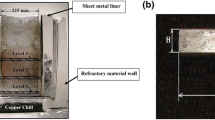Abstract
The addition of aluminium to K, Si-doped molybdenum leads to higher potassium and silicon contents in the final sintered rods. The increase is proportional to the Al-concentration. The increase of potassium and silicon is caused by the formation of potassium-alumosilicates and potassium aluminates which were identified by AES. The addition of A13+ surprisingly shows a strong gettering effect on grain boundaryoxygen. The long interconnected system of pores in the sintered rod, causing splitting etc., is destroyed by addition of aluminium.
Similar content being viewed by others
References
T. Takebe, T. Akiyama, K. Shimatani, M. Endoh,Properties of Doped Molybdenum Sheet, Tokyo Tungsten Company, Tokyo, December 1985.
Tsch. W. Kopecky, A. J. Paschkowsky,Planseeberichte für Pulvermetallurgie 1971,19, 7.
F. Benesovsky, P. Braun, W. Färber, E. Lassner, H. Petter, B. Tiles, F. P. Viehböck,Planseeberichte für Pulvermetallurgie 1975,23, 101.
E. Fromm, G. Hörz,Internat. Metals Rev. 1980,5/6, 259.
H. Hofmann, M. Grosskopf, M. Hofmann-Amtenbrink, G. Petzow,Powder Metallurgy 1986,29, No. 3.
Author information
Authors and Affiliations
Rights and permissions
About this article
Cite this article
Setti, C. AES investigations of fracture surfaces of aluminium doped sintered molybdenum rods. Mikrochim Acta 91, 437–444 (1987). https://doi.org/10.1007/BF01199519
Received:
Issue Date:
DOI: https://doi.org/10.1007/BF01199519




